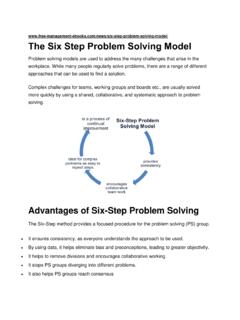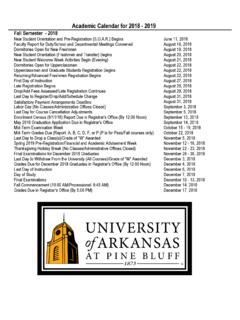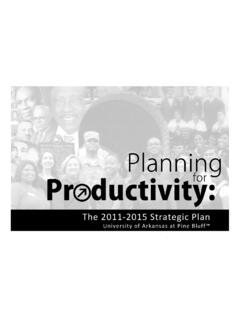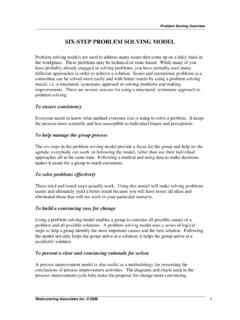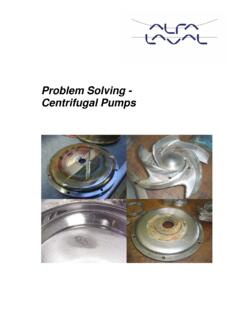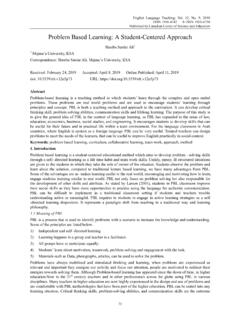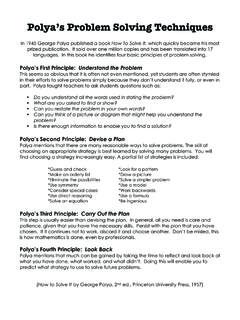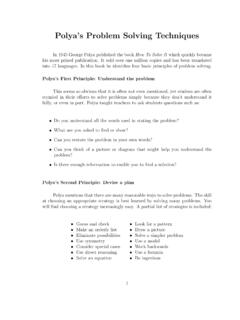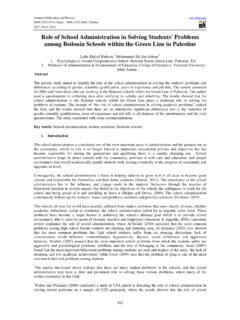Transcription of THIRTEEN PROBLEM-SOLVING MODELS
1 4/5/2020 THIRTEEN PROBLEM-SOLVING MODELS FRED NICKOLS DISTANCE CONSULTING LLC This page intentionally left blank. Analytical PROBLEM-SOLVING Approach - FEMA Fred Nickols 2020 problem Solver s Tool Kit Page 1 Step Description Step 1: Identify the problem Determine the situation or condition that will exist in the future and is considered undesirable by members of the organization. In order to identify the problem , you need to size up the situation to make sure that you have the full picture. Size-up involves analyzing the current situation to determine: What is happening (and not happening). Who is involved. What the stakes are. This information will enable you to identify the problem more accurately. Step 2: Explore the Alternatives This step includes generating alternatives and evaluating them. You can generate alternatives through brainstorming, surveys, discussion groups, or other means.
2 Alternatives should be evaluated using a consistent process. In a crisis, exploring alternatives involves: Identifying contingencies. Consider the future and think about all of the things that can get in the way of solving the problem you are facing. Determining objectives. Develop objectives that clearly state what you need to do to be successful. Identifying needed resources. Identify the people, information (data), and things needed to resolve the problem . Analytical PROBLEM-SOLVING Approach - FEMA Fred Nickols 2020 problem Solver s Tool Kit Page 2 Step Description Step 3: Select an Alternative After you have evaluated each alternative, select the alternative that comes closest to solving the problem with the most advantages and fewest disadvantages. There may be repercussions to any solution selected. Carefully consider how the solution will be implemented before selecting an alternative. In a crisis, selecting an alternative involves building a plan that states: Who Will do what (and with whom) By when Where How Plans need to be communicated to all parties involved.
3 Step 4: Implement the Solution Take action to implement the selected solution. Implementation involves the following: Developing an action plan (what steps are needed). Determining objectives or measurable targets. Identifying needed resources. Identifying details of the action plan (who will do what, by when, where, and how, as applicable). Using the plan to put the solution in place. Step 5: Evaluate the Situation Evaluation involves monitoring progress and evaluating the decision that was made. During evaluation, identify if: the situation has changed, more or fewer resources are required, or a different alternative solution is required. Monitoring the success of a solution is an ongoing process that is critical to fine tuning a course of action. For FEMA Training using this model see: ASQ Four-Step Model Fred Nickols 2020 problem Solver s Tool Kit Page 3 The American Society for Quality (ASQ) argues that to effectively manage and run a successful organization, leadership must guide their employees and develop PROBLEM-SOLVING techniques.
4 ASQ further asserts that finding a suitable solution for issues can be accomplished by following the four-step PROBLEM-SOLVING process and methodology outlined below. Step Characteristics 1. Define the problem Differentiate fact from opinion Specify underlying causes Consult each faction involved for information State the problem specifically Identify what standard or expectation is violated Determine in which process the problem lies Avoid trying to solve the problem without data ASQ Four-Step Model Fred Nickols 2020 problem Solver s Tool Kit Page 4 Step Characteristics 2. Generate Alternatives Postpone evaluating alternatives initially Include all involved individuals in the generating of alternatives Specify alternatives consistent with organizational goals Specify short- and long-term alternatives Brainstorm on others' ideas Seek alternatives that may solve the problem 3.
5 Evaluate and Select Solution Evaluate alternatives relative to a target standard Evaluate all alternatives without bias Evaluate alternatives relative to established goals Evaluate both proven and possible outcomes State the selected alternative explicitly 4. Implement and Evaluate Plan and implement a pilot test of the chosen alternative Gather feedback from all affected parties Seek acceptance or consensus by all those affected Establish ongoing measures and monitoring Evaluate long-term results based on final solution Source: Creative PROBLEM-SOLVING Model - Mindtools Fred Nickols 2020 problem Solver s Tool Kit Page 5 1. Clarify Explore the Vision Identify your goal, desire or challenge. This is a crucial first step because it's easy to assume, incorrectly, that you know what the problem is. However, you may have missed something or have failed to understand the issue fully and defining your objective can provide clarity.
6 Read our article, 5 Whys , for more on getting to the root of a problem quickly. Gather Data Once you've identified and understood the problem , you can collect information about it and develop a clear understanding of it. Make a note of details such as who and what is involved, all the relevant facts, and everyone's feelings and opinions. Formulate Questions When you've increased your awareness of the challenge or problem you've identified, ask questions that will generate solutions. Think about the obstacles you might face and the opportunities they could present. Creative PROBLEM-SOLVING Model - Mindtools Fred Nickols 2020 problem Solver s Tool Kit Page 6 2. Ideate Explore Ideas Generate ideas that answer the challenge questions you identified in step 1. It can be tempting to consider solutions that you've tried before, as our minds tend to return to habitual thinking patterns that stop us from producing new ideas.
7 However, this is a chance to use your creativity . Brainstorming and Mind Maps are great ways to explore ideas during this divergent stage of CPS. And our articles, Encouraging Team Creativity , /community/Bite- problem solving , Rolestorming , Hurson's Productive Thinking Model , and The Four-Step Innovation Process , can also help boost your creativity. 3. Develop Formulate Solutions This is the convergent stage of CPS, where you begin to focus on evaluating all of your possible options and come up with solutions. Analyze whether potential solutions meet your needs and criteria and decide whether you can implement them successfully. Next, consider how you can strengthen them and determine which ones are the best "fit." Our articles, Critical Thinking and ORAPAPA , are useful here. 4. Implement Formulate a Plan Once you've chosen the best solution, it's time to develop a plan of action. Start by identifying resources and actions that will allow you to implement your chosen solution.
8 Next, communicate your plan and make sure that everyone involved understands and accepts it. Source: Note: The embedded links above are to articles on the MindTools site. Fred Nickols Four-Step Model Fred Nickols 2020 problem Solver s Tool Kit Page 7 As the diagram below indicates, the PROBLEM-SOLVING process consists of four major steps: 1. ASSESS: Take Stock of the Situation 2. ANALYZE: Figure Out What to Do About It 3. ORGANIZE: Get Ready for Action 4. EXECUTE: Make It Happen Each of the four steps is described in more detail in the table on the following page. Fred Nickols Four-Step Model Fred Nickols 2020 problem Solver s Tool Kit Page 8 Investigation Intervention ASSESS ANALYZE ORGANIZE EXECUTE Take Stock of the Situation Figure Out What to Do About It Get Ready for Action Make It Happen Clarify the Situation - establish its boundaries - determine its nature - understand & explain it - describe it Specify the Outcomes - achieve - preserve - avoid - eliminate Classify the Structure - physical - financial - operational - behavioral Tend to the Politics - consensus - support - opposition - communication Choose an Approach - repair - improve - engineer Diagram the Structure - elements - connections - relationships Identify change Targets, Changes.
9 And Means - what is to be changed - in what ways - through what means Specify the General Form of the Solution - what are you going to do - over what time frame - using what methods - at what costs - why Reconcile Result, Resource & Time Conflicts - reconcile restraints - reconcile constraints - obtain funding - obtain other resources Prepare an Action Plan - tasks & assignments - milestones & events - contingencies Settle on A change Management Strategy - persuasion - education - coercion - adaptation Tend to the Politics - consensus - support - opposition - communication Carry Out the Solution - act - assess - adjust Appraise the Situation - better or worse - closer or farther - enough or more - same or different Evaluate the Solution and Its Implementation - effectiveness - efficiency - costs and benefits Critique the Effort - mistakes made - lessons learned - tips for next time The IDEAL PROBLEM-SOLVING Model Fred Nickols 2020 problem Solver s Tool Kit Page 9 The IDEAL model, shown below, presents five steps or phases involved in solving a problem .
10 It was originally developed by John Bransford and published in 1984 a book titled The IDEAL problem Solver. Bransford and Barry Stein published a second edition in 1993. The process, as they describe it, is cyclical or iterative and does not call for a rigid, linear approach. Each of the five steps or phases is briefly discussed below. Identify Problems and Opportunities The aim is to identify potential problems and treat them as opportunities. People often fail to do this because they take unpleasant circumstances as givens and do not stop to think about the possibilities of improving upon the situation. Another issue in this stage relates to the failure to realize that current actions underway or policies being put into effect might lead to problems later on. It is important, then, to give thought to current actions and policies with an eye toward predicting future problems. The IDEAL PROBLEM-SOLVING Model Fred Nickols 2020 problem Solver s Tool Kit Page 10 Define Goals The objective here is to carefully define your goals with respect to the problem situation.
